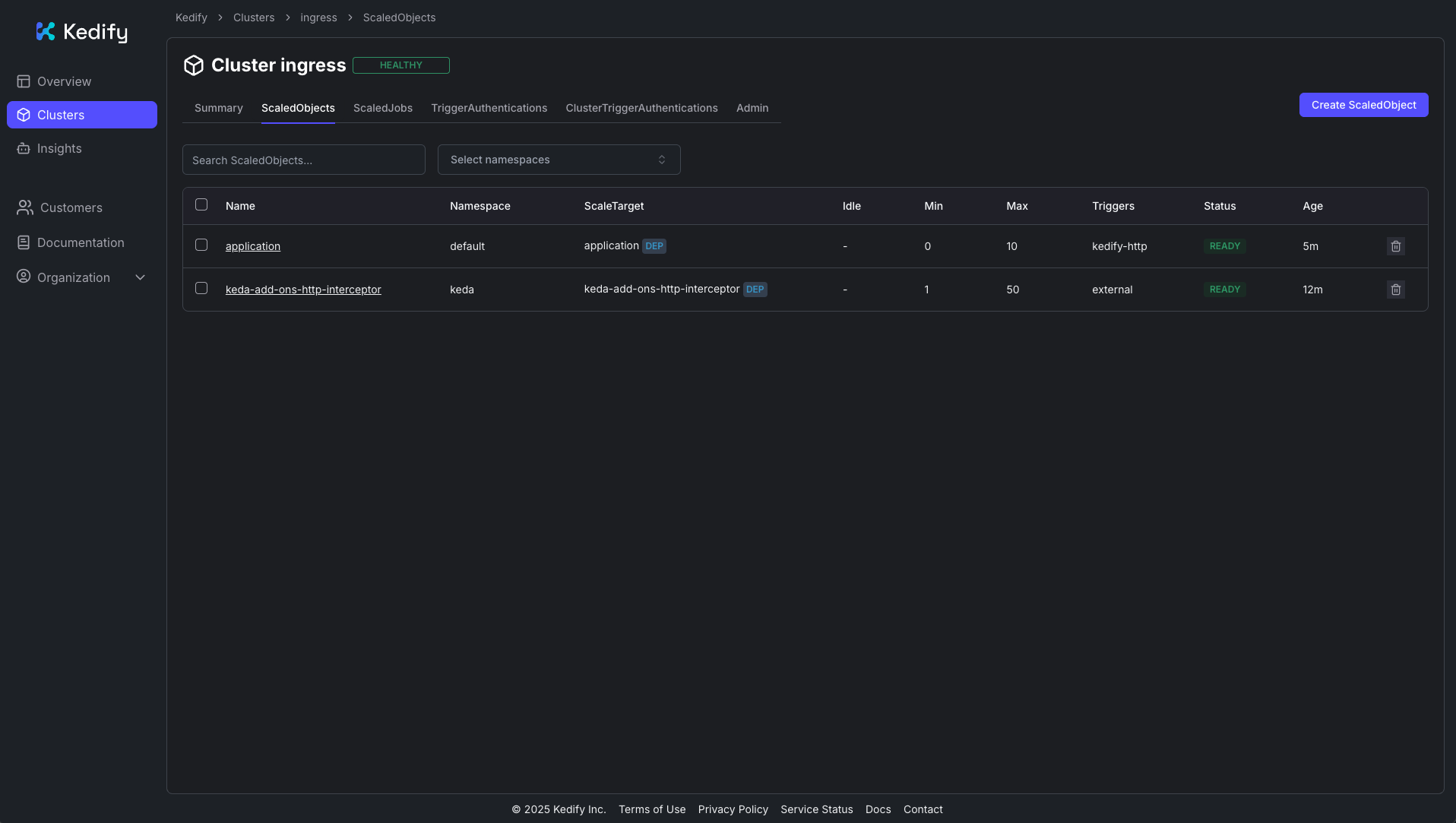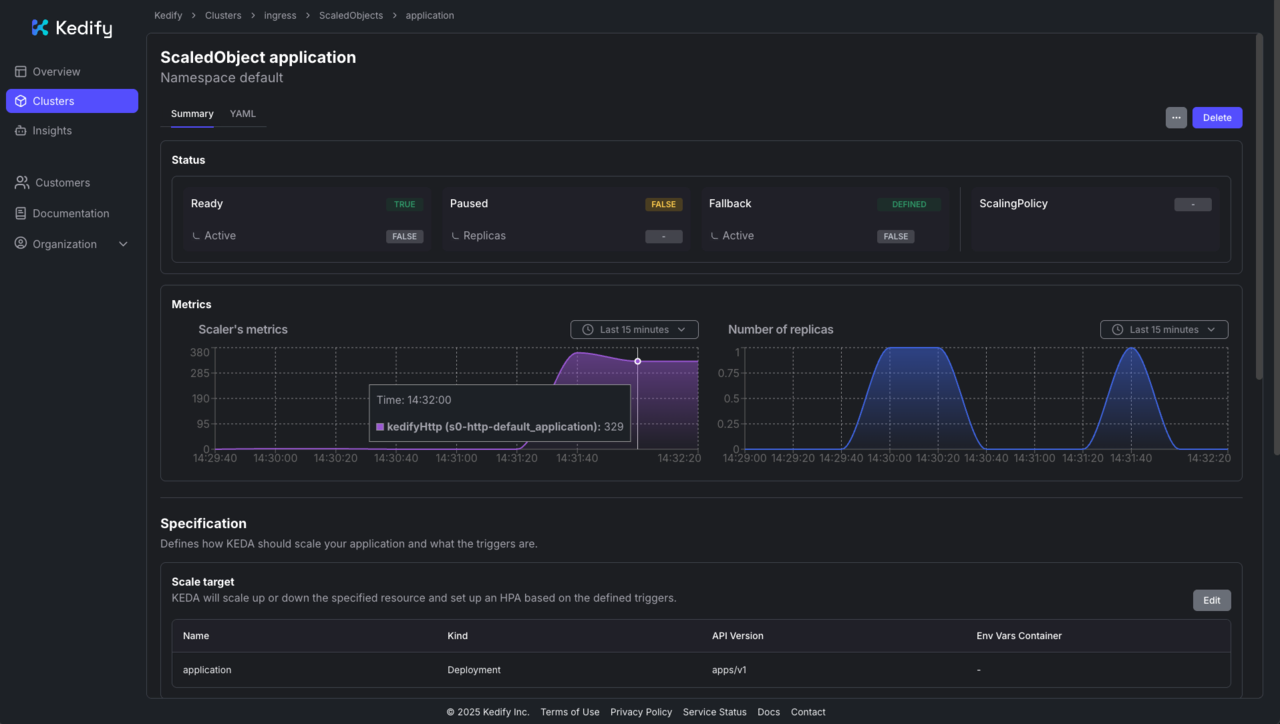Autoscale HTTP applications on Kubernetes with KEDA and Kedify
Introduction
Install Kedify using Helm
Install an ingress controller
Autoscale HTTP applications with Kedify and Kubernetes Ingress
Next Steps
Autoscale HTTP applications on Kubernetes with KEDA and Kedify
Overview
In this section, you’ll gain hands-on experience with Kedify HTTP autoscaling. You will deploy a small web service, expose it through a standard Kubernetes Ingress, and rely on Kedify’s autowiring to route traffic through its proxy so that requests are measured and drive scaling.
You will scale a real HTTP app exposed through Kubernetes Ingress using Kedify’s HTTP Scaler , and then move on to deploy a simple application, enable autoscaling with a scaled object, generate load, and observe the system scale out and back in (including scale-to-zero when idle).
For more information, see Scaling Deployments, StatefulSets & Custom Resources on the KEDA website.
How it works
With ingress autowiring enabled, Kedify automatically routes traffic through its proxy before it reaches your service and deployment:
Ingress → kedify-proxy → Service → Deployment
The Kedify proxy gathers request metrics used by the scaler to make decisions.
Deployment overview
There are three main components involved in the process:
- For the application deployment and service, there is an HTTP server with a small response delay to simulate work.
- For ingress, there is a public entry point that is configured using the
application.kedahost. - For the ScaledObject, there is a Kedify HTTP scaler using
trafficAutowire: ingress.
Configure the Ingress IP environment variable
Before testing the application, make sure the INGRESS_IP environment variable is set to your ingress controller’s external IP address or hostname.
If you followed the Install Ingress Controller guide, you should already have this set. If not, or if you’re using an existing ingress controller, run this command:
export INGRESS_IP=$(kubectl get service ingress-nginx-controller --namespace=ingress-nginx -o jsonpath='{.status.loadBalancer.ingress[0].ip}{.status.loadBalancer.ingress[0].hostname}')
echo "Ingress IP/Hostname: $INGRESS_IP"
This will store the correct IP or hostname in the $INGRESS_IP environment variable. If no value is returned, wait a short while and try again.
If your ingress controller service uses a different name or namespace, update the command accordingly. For example, some installations use nginx-ingress-controller or place it in a different namespace.
Deploy the application and configure Ingress
Now you will deploy a simple HTTP server and expose it using an Ingress resource. The source code for this application is available on the Kedify GitHub repository .
Run the following command to deploy your application:
cat <<'EOF' | kubectl apply -f -
apiVersion: apps/v1
kind: Deployment
metadata:
name: application
spec:
replicas: 1
selector:
matchLabels:
app: application
template:
metadata:
labels:
app: application
spec:
nodeSelector:
kubernetes.io/arch: arm64
tolerations:
- key: "kubernetes.io/arch"
operator: "Equal"
value: "arm64"
effect: "NoSchedule"
containers:
- name: application
image: ghcr.io/kedify/sample-http-server:latest
imagePullPolicy: Always
ports:
- name: http
containerPort: 8080
protocol: TCP
env:
- name: RESPONSE_DELAY
value: "0.3"
---
apiVersion: v1
kind: Service
metadata:
name: application-service
spec:
ports:
- name: http
protocol: TCP
port: 8080
targetPort: http
selector:
app: application
type: ClusterIP
---
apiVersion: networking.k8s.io/v1
kind: Ingress
metadata:
name: application-ingress
spec:
ingressClassName: nginx
rules:
- host: application.keda
http:
paths:
- path: /
pathType: Prefix
backend:
service:
name: application-service
port:
number: 8080
EOF
Key settings explained
The manifest includes a few key options that affect scaling behavior:
RESPONSE_DELAYis set in the Deployment manifest above and adds approximately 300 ms latency per request; this slower response time increases the number of concurrent requests, making scaling effects easier to observe.- The ingress uses the host
application.keda. To access this app, use your Ingress controller’s IP with aHost:header.
Verify the application is running
Run the following command to check that 1 replica is ready:
kubectl get deployment application
Expected output includes 1 available replica:
NAME READY UP-TO-DATE AVAILABLE AGE
application 1/1 1 1 3m44s
Test the application
Once the application and Ingress are deployed, verify that everything is working correctly by sending a request to the exposed endpoint. Run the following command:
curl -I -H "Host: application.keda" http://$INGRESS_IP
If the routing is set up properly, you should see a response similar to:
HTTP/1.1 200 OK
Date: Thu, 11 Sep 2025 14:11:24 GMT
Content-Type: text/html
Content-Length: 301
Connection: keep-alive
Enable autoscaling with Kedify
The application is now running. Next, you will enable autoscaling so that it can scale dynamically between 0 and 10 replicas. Kedify ensures that no requests are dropped during scaling. Apply the ScaledObject by running the following command:
cat <<'EOF' | kubectl apply -f -
apiVersion: keda.sh/v1alpha1
kind: ScaledObject
metadata:
name: application
spec:
scaleTargetRef:
apiVersion: apps/v1
kind: Deployment
name: application
cooldownPeriod: 5
minReplicaCount: 0
maxReplicaCount: 10
fallback:
failureThreshold: 2
replicas: 1
advanced:
restoreToOriginalReplicaCount: true
horizontalPodAutoscalerConfig:
behavior:
scaleDown:
stabilizationWindowSeconds: 5
triggers:
- type: kedify-http
metadata:
hosts: application.keda
pathPrefixes: /
service: application-service
port: "8080"
scalingMetric: requestRate
targetValue: "10"
granularity: 1s
window: 10s
trafficAutowire: ingress
EOF
Key fields explained
Use the following field descriptions to understand how the ScaledObject controls HTTP-driven autoscaling and how each setting affects traffic routing and scale decisions:
type: kedify-http- Uses Kedify’s HTTP scaler.hosts,pathPrefixes- Define which requests are monitored for scaling decisions.service,port- Identify the Kubernetes Service and port that receive traffic.scalingMetric: requestRate,granularity: 1s,window: 10s,targetValue: "10"- Scales out when the average request rate exceeds ~10 requests/second (rps) per replica over the last 10 seconds.minReplicaCount: 0- Enables scale to zero when there is no traffic.trafficAutowire: ingress- Automatically wires your Ingress to the Kedify proxy for seamless traffic management.
After applying, the ScaledObject will appear in the Kedify dashboard (
https://dashboard.kedify.io/)
.
 Kedify dashboard: ScaledObject
Kedify dashboard: ScaledObject
Send traffic and observe scaling
Since no traffic is currently being sent to the application, it will eventually scale down to zero replicas.
Verify scale to zero
To confirm that the application has scaled down, run the following command and watch until the number of replicas reaches 0:
watch kubectl get deployment application -n default
You should see output similar to:
Every 2,0s: kubectl get deployment application -n default
NAME READY UP-TO-DATE AVAILABLE AGE
application 0/0 0 0 110s
This continuously monitors the deployment status in the default namespace. Once traffic stops and the idle window has passed, you should see the application deployment report 0/0 replicas, indicating that it has successfully scaled to zero.
Verify the app can scale from zero
Send a request to trigger scale-up:
curl -I -H "Host: application.keda" http://$INGRESS_IP
You should receive an HTTP 200 OK response, confirming that the service is reachable again.
The application scales from 0 → 1 replica automatically, and you should receive an HTTP 200 OK response.
Now, generate a heavier, sustained load against the application. You can use hey (or a similar benchmarking tool):
hey -n 40000 -c 200 -host "application.keda" http://$INGRESS_IP
While the load test is running, open another terminal and monitor the deployment replicas in real time:
watch kubectl get deployment application -n default
You will see the number of replicas change dynamically. For example:
Every 2,0s: kubectl get deployment application -n default
NAME READY UP-TO-DATE AVAILABLE AGE
application 5/5 5 5 23m
Expected behavior:
- On bursty load, Kedify scales the Deployment up toward
maxReplicaCount. - When traffic subsides, replicas scale down. After the cooldown, they can return to zero.
You can also monitor traffic and scaling in the Kedify dashboard:
 Kedify dashboard: request load and scaling over time
Kedify dashboard: request load and scaling over time
Clean up
When you have finished testing, remove the resources created in this Learning Path to free up your cluster:
kubectl delete scaledobject application
kubectl delete ingress application-ingress
kubectl delete service application-service
kubectl delete deployment application
This will delete the ScaledObject, Ingress, Service, and Deployment associated with the demo application.
Next steps
To go further, you can explore the Kedify How-To Guides for more configurations such as Gateway API, Istio VirtualService, or OpenShift Routes.